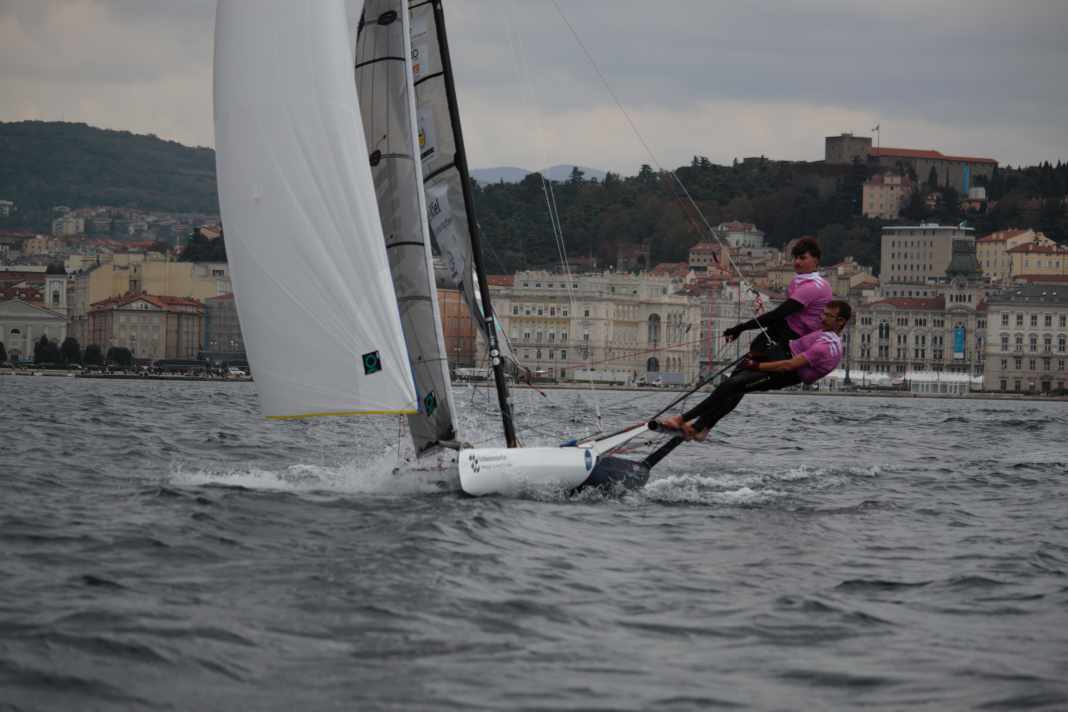





"We achieved our goal, we wanted to get there and get a rating after all these years and we did it. The boat didn't break, all the parts held up," summarised the team captain of the university sailing team Förderacer Lucas Hummel on site in Trieste. The team from Kiel was the only one to receive full points in the Innovation Award presented during the regatta. On the water, however, the crew led by Richard Heinel and Justin Bednarek were not yet able to catch up with the front runners.
"On the first day of the race, we struggled with severe trimming problems and first had to learn how to tack this boat in light winds. That was a bit tricky," says foresailor Bednarek. On the second day, the crew was then confronted with the complete opposite, so they decided to return to shore early to minimise the risks, he explains. "We had problems with our Dyneema shrouds and almost had a mast break, which is why we decided to abort so that we could train in Kiel in the autumn and then optimise the boat in the winter."
After all, it was clear from the outset that the project would continue regardless of the outcome. "We are incredibly happy to have travelled there and to have taken part. The team is proud of itself and I'm also proud of the whole team," said Lucas Hummel. The team had been taking on this special challenge since 2019, when the innovative wave piercer design was presented to the public for the first time at boot Düsseldorf 2024. reported in detail on the team and the special features of its design.
To take part in the 1001 Vela Cup, the design had to be 4.60 metres long, 2.10 metres wide and have a total sail area of 33 square metres. Above all, however, the skiff must be made of at least 75 per cent recyclable materials. This is because glass fibre reinforced plastic (GRP) is still the standard in conventional yacht construction. However, the composite material is controversial: its production consumes a lot of energy and the epoxy resins used to laminate the glass fibre layers are based on crude oil. What's more, GRP cannot be recycled satisfactorily. For this reason, efforts are also being made in boatbuilding to use other materials.
Before the Vela Cup: Kieler Förderacer make last-minute repairs
The students from Kiel managed this brilliantly, but there were setbacks in the immediate preparation for the Vela Cup when both the centreboard and rudder broke during the first sailing session. "One week before the Vela Cup, we then produced new appendages in a 24-hour shift, so to speak," says the team captain. He himself is always amazed by the incredible commitment of his crew, totalling around 30 shipbuilding, mechanical engineering, business administration and media students. "When it comes down to it, it works perfectly and that's always great to see."
However, the boat named "Layliner powered by BWT" has one clear weakness among its many strengths. Unlike in the America's Cup, for example, the teams help each other on and off the water. Not only were the young shipbuilders from Kiel able to utilise the workshop at Trieste University, but they also completed the final adjustment strokes and training races together on the water before the regatta.
After the competition is before the optimisation
In addition to great gratitude for the collegial relationships between the teams, Bednarek's conclusion on the sporting side is: "We have seen that the boat can keep up with the field in terms of speed, as long as we get the trim right so that we can keep up with the altitude." Even if it was still too much at the end of the regatta, the sustainable skiff should be able to cope with more wind in the future so that it can also sail on the Kiel Fjord at home.
The future engineers have equipped their boat with extensive sensors for the subsequent optimisation. "We want to know how forces and tensions affect the boat in order to find out more about the strength and stability of our flax fibre sandwich construction," explains Hummel. "With the help of strain gauges, we can link the measurement data to environmental conditions such as wind force, wave height, temperature and trim," adds his team colleague Justin Bednarek. "We even built the required sensors ourselves because standard components don't capture what we need."
The rig with an aluminium composite mast, on the other hand, was recycled from a 49er and the sails are new. "The sails are made from a polyester film laminate and are therefore unfortunately not sustainable," regrets team boss Lucas Hummel. "However, the producers are already working on recycled polyester materials for sails, which gives us hope for the future."
Two more German universities at the start of the Vela Cup
The Impetus Sailing team from the Technical University of Munich also still has to make do with conventional cloth. Unlike their northern German competitors, however, they have opted for basalt fibre combined with a recycled foam core and a thermoplastic matrix system for the construction of the hull. This achieves performance values above those of conventional glass fibre systems.
What's more, every component can be recovered from this system and fed back into the circular cycle, says mechanical engineering student and team founder Benjamin Wittmann. He continues: "Our negative moulds are 3D printed to ensure that production is as sustainable as possible. This means we only need a minimum of material for the mould compared to conventional negative moulds and can shred them almost completely and print them into a new negative mould." The team from Karlsruhe University of Applied Sciences completed the German representation in Trieste.

